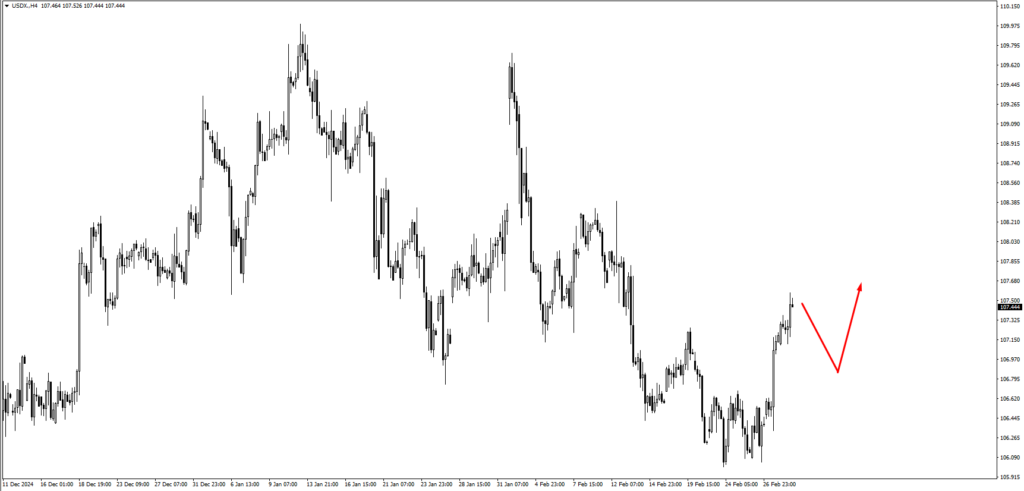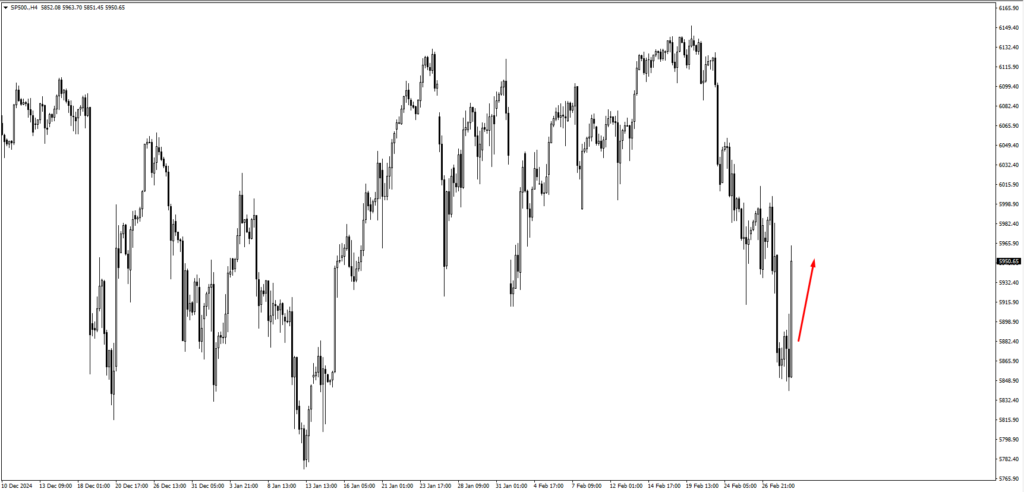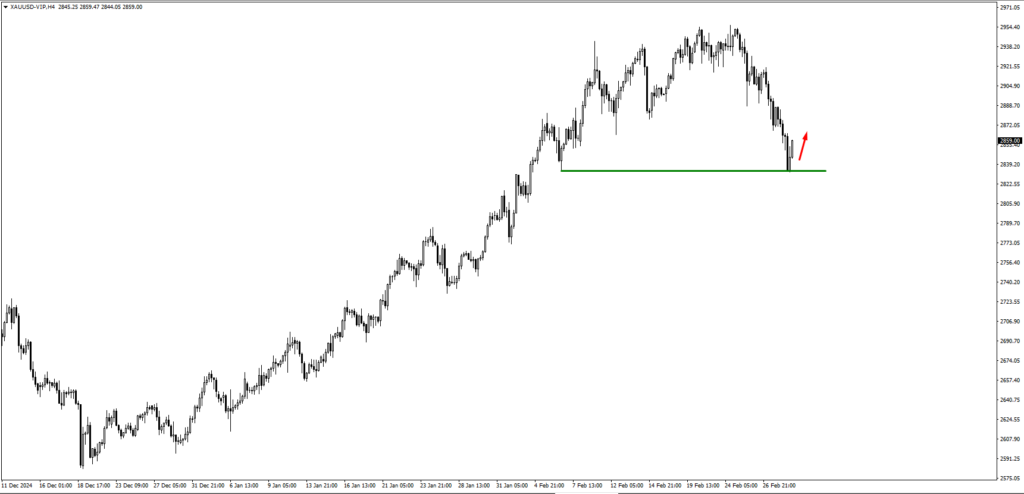
The air feels different when trade wars flare up. The quiet hum of financial markets turns into a low, rumbling growl—uncertain, watchful, ready to snap. Traders don’t like guessing games, and yet here we are again, parsing the latest round of tariffs and their potential domino effect across the global economy.
President Trump’s latest round of tariffs—25% on Canadian and Mexican imports, 10% on Chinese goods, and a particularly sharp 10% levy on Canadian oil—has put the market on edge. These aren’t just numbers on a policy sheet; they are pressure points in a system already balancing on a knife’s edge. The moves have fuelled reactions across key asset classes, and the market is playing tug-of-war with itself as traders assess what comes next.
The U.S. dollar, ever the safe harbour in a storm, has responded with strength. The U.S. Dollar Index (USDX) rose 1.28% to 109.75 as traders piled in, a classic knee-jerk reaction when uncertainty flares—this time fueled by renewed tariff tensions, shifting Fed expectations, and a cautious equity market teetering near resistance.
A strong dollar has its pros and cons. On one hand, it signals confidence in the U.S. economy; on the other, it makes American exports pricier, chipping away at trade competitiveness. If tariffs stick and trade partners retaliate, we could see the dollar firm up further, but that strength comes with a cost. Inflation? Not necessarily—but pressure on corporate earnings? That’s a real risk.
Then there’s the S&P 500 (SP500), which has been riding this storm like a ship in heavy waters. The broad index has seen choppy trading, with Goldman Sachs estimating that every five-percentage-point increase in tariffs shaves 1-2% off corporate earnings per share. That’s not pocket change. A full 5% hit to earnings is the kind of drag that ripples across sectors, and companies that rely on global supply chains—think tech, automotive, and industrials—are feeling the heat first. Traders aren’t running for the exits yet, but there’s an undeniable air of caution. If earnings compression starts to show up in upcoming reports, the market may start re-pricing risk at a faster clip.
Meanwhile, gold (XAUUSD) has been making its move, gleaming as the ultimate hedge against uncertainty. The yellow metal shot up over 7% since January 20, touching $2,942.70 per ounce. This isn’t just safe-haven buying—it’s also a hedge against currency fluctuations and inflationary pressures that could arise if trade disruptions linger. If the S&P starts slipping and dollar strength wobbles under the weight of policy uncertainty, gold could push even higher. But if traders start to believe that tariffs won’t escalate further, some of that safety premium might unwind.
Market Performance This Week
This past week, financial markets have been caught in a delicate balancing act. With Trump’s tariff policies casting long shadows, traders have been recalibrating their strategies, watching key technical levels for signals on the next major move.
The U.S. Dollar Index (USDX) has been climbing steadily, reaching 107.60. With market sentiment favoring safe-haven assets amid tariff concerns, the dollar could push higher—provided it holds key consolidation levels.

Traders will be watching 107.25 and 106.50 closely; if these zones hold, a fresh leg higher could be in the works. However, any break below these levels might signal exhaustion, opening the door for a retracement.
In equities, the S&P 500 (SP500) has been hovering around the 5,950 level, a critical area that traders have been monitoring for a potential shift in momentum.

However, the rally leading up to this level has been impulsive, triggering caution for those eyeing short positions. Should the index break higher, 6,020 will be a zone to watch for resistance. If sellers step in, a retracement back toward lower levels could develop, marking a cooling-off period after weeks of upside movement.
Gold (XAU/USD) remains in focus after testing a low of 2,834.20 before bouncing back. The 2,875 level is now the next key resistance point where price action will determine the next move.

If buyers maintain control, the rally could continue, especially with market jitters favoring safe-haven assets. However, any rejection at resistance may prompt another leg lower.
Over in cryptocurrencies, Bitcoin (BTC) has been making waves after bouncing from the lower end of its monitored 80,000 range. A breakout above 90,000 with strong consolidation could invite fresh buyers into the market. But if sellers regain control, the next key support sits around 74,000—a level where bulls may try to defend against further downside.
For forex traders, major pairs are offering plenty of setups. EUR/USD took out the 1.03726 low, hinting at potential upside momentum. However, traders will be watching for bearish price action at 1.0405 and, if the rally extends, at 1.0465 as well. Similarly, GBP/USD is approaching 1.2660, a level where sellers may begin stepping in. Meanwhile, USD/JPY could test 151.70, and if it consolidates, a bullish continuation could emerge near 149.50.
Commodities are also seeing critical movements. Crude oil (USOIL) has been climbing, with 71.00 and 72.45 acting as key resistance levels to watch for potential bearish price action. Natural gas traders will be watching 3.72 for a possible bullish bounce if prices trade lower.
Events This Week
Tuesday, March 4, brings a key speech from Bank of Japan Governor Ueda. With the USD/JPY pair in a consolidation phase, traders will be watching for any hints on policy shifts. If Governor Ueda signals a firmer stance on monetary tightening, the yen could gain traction, putting downward pressure on USD/JPY.
Wednesday, March 5, features a trio of market-moving data points. Australia’s GDP (q/q) is expected to come in at 0.50%, up from the previous 0.30%. If this forecast holds, it would reinforce optimism around the Australian economy, giving the AUD/USD a potential short-term lift before encountering resistance at higher levels. The Swiss CPI (m/m) is also projected at 0.50%, rebounding from -0.10%. A stronger-than-expected inflation figure could bolster the CHF, leading to possible weakness in USD/CHF. Meanwhile, in the U.S., the ISM Services PMI is set to rise slightly to 53.0 from 52.8. A stronger reading would likely support the dollar, particularly if it signals resilience in the service sector.
On Thursday, March 6, the European Central Bank’s Main Refinancing Rate is expected to decline to 2.65% from 2.90%. A rate cut or dovish rhetoric could put pressure on the EUR/USD, opening the door for further downside moves. Traders will be assessing whether the ECB signals a longer-term easing cycle or maintains a cautious outlook on inflation.
Friday, March 7, delivers a high-impact event: the U.S. Non-Farm Payrolls (NFP) report. The market is expecting 156K new jobs, up from the previous 143K, while the unemployment rate is projected to hold steady at 4.00%. If the labor market surprises to the upside, expectations for a more hawkish Federal Reserve could resurface, reinforcing the U.S. dollar and pressuring equities. However, a weaker-than-expected report could reignite concerns about economic slowdown, potentially weighing on the dollar and fueling a rally in gold.
With markets on edge and policy shifts rewriting the playbook, traders will need to stay sharp. As President Trump’s tariff threats continue unfolding and global economies pivot to match, the scales remain in flux. This week’s U.S. jobs data, the ECB’s rate decision, and fresh inflation prints will test market resilience.









